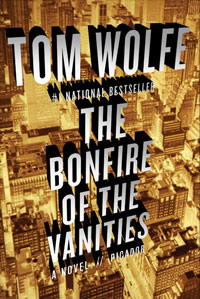New York: Farrar Straus Giroux, 1987.
Summary from Publisher:
Sherman McCoy, the central figure of Tom Wolfe’s first novel, is a young investment banker with a fourteen-room apartment in Manhattan. When he is involved in a freak accident in the Bronx, prosecutors, politicians, the press, the police, the clergy, and assorted hustlers high and low close in on him, licking their chops and giving us a gargantuan helping of the human comedy of New York in the last years of the twentieth century, a city boiling over with racial and ethnic hostilities and burning with the itch to Grab It Now. Wolfe’s gallery ranges from Wall Street, where people in their thirties feel like small-fry if they’re not yet making a million per, to the real streets, where the aim is lower but the itch is just as virulent.
We see this feverish landscape through the eyes of McCoy’s wife and his mistress; the young prosecutor for whom the McCoy case would be he answer to a prayer; the ne’er-do-well British journalist who needs such a case to save his career in America; the street-wise Irish lawyer who becomes McCoy’s only ally; and Reverend Bacon of Harlem, a master manipulator of public opinion. Above all, we see what happens when the criminal justice system-gorged with “the chow,” as the Bronx prosecutor calls the borough’s usual black and Latin felons-considers the prospect of being banded a prime cut like Sherman McCoy of Park Avenue.
The Bonfire of the Vanities is a novel, but it is based on the same sort of detailed on-scene reporting as Wolfe’s great nonfiction bestsellers, The Right Stuff, Radical Chic & Mau-Mauing the Flak Catchers, and The Electric Kool-Aid Acid Test. And it is every bit as eye-opening in its achievements. It is a big, panoramic story of the metropolis–the kind of fiction strangely absent from our literature in the second half of this century-that reinforces Tom Wolfe’s reputation as the foremost chronicler of the way we live in America.
Online:
TomWolfe.com (excerpt)
Amazon

